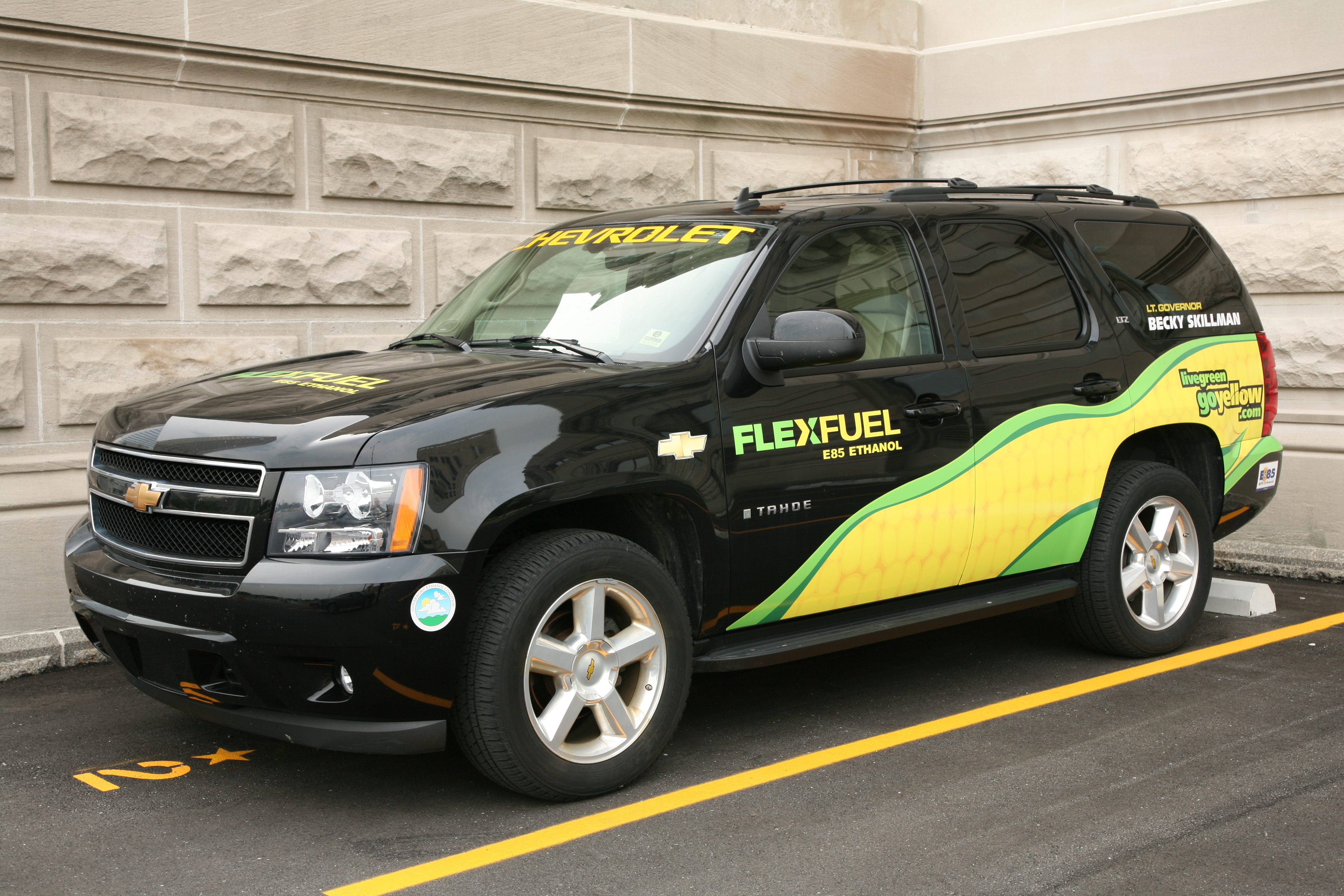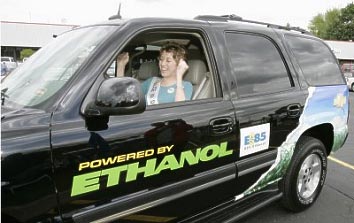Flexible Fuel Vehicle
A Flexible Fuel Vehicle (FFV, sometimes also called Flexible Fuel Vehicle) - to German as " adaptable to the fuel vehicle " - is a vehicle that can run on petrol, the alcohols methanol and ethanol, as well as any mixtures of these three fuels. The term is clearly demarcated to the Germans in the similar-sounding multi-fuel engine, which burns a variety of fuels and engines that run on diesel fuel or biodiesel.
The meaning of such a concept is the preferably use of ( bio) alcohols, in their temporal or regionally restricted unavailability also a petrol operation possible and therefore, in contrast to pure alcohol vehicles ensures the mobility of the vehicle operator is.
Technology
Substantial modifications of an FFV compared to gasoline-powered vehicles are:
- Adaptation of mixture formation and ignition of the respective fuels
- Using a sensor for determining the actual alcohol content in the fuel ( alcohol sensor )
- Alcohol- resistant materials in the fuel cycle (tank, fuel pump, fuel lines, injectors )
- For any specific engine oils and material adjustments to the engine
While vehicles are designed for gasoline-alcohol blend fuels or pure alcohol operation already in the 80s and put into operation (mainly Brazil), the development of the FF technique began in the early 1990s, following appropriate alcohol sensors were available. In the United States, focusing California, extensive fleet tests were then mixed with the methanol fuel M85 performed (CEC 's Light - Duty Methanol Fuel Flexible Vehicle Demonstration Program), which also involved the German automaker Mercedes -Benz and Volkswagen involved. The latter also developed the first optimized for the U.S. market and specifically for ethanol fuel E85 FFV, which were subsequently used in the Illinois Corn Marketing Board for demonstration and testing purposes, according to his own admission, however, mainly to motivate the domestic auto industry to develop such concepts.
Because of the anticipated reduction in crude oil reserves and increasing pollution for several years worldwide increased interest in the FF technique make out, but now focusing on the use of bioethanol to reduce greenhouse gas emissions ( carbon dioxide ).
A suitable for FFV capacitive alcohol sensor developed by Siemens in cooperation with Mercedes -Benz and Volkswagen, after the optical sensors had not been successful due to systemic problems. This sensor measures the change in capacitance, the conductivity and the temperature of the fuel and then calculates the alcohol content of which is passed as a digital output signal to the control device so that the injection amount and ignition timing are adjusted according to the current fuel composition. Because of the lower heating values of alcohols to gasoline at the M85 operating almost twice the amount of fuel per injection is necessary in E85 about a third more; Accordingly, the fuel system has to be adapted (flow rate of the fuel pump, larger fuel tank, etc.).
( Hence the designation M85 or E85) Both methanol and ethanol fuel containing a supplement of 15 percent special volatile hydrocarbons or in the simplest case of gasoline. This addition is focused on optimizing the critical case of pure alcohols cold start and cold-running characteristics below about 15 ° C and for safety reasons the displacement of the upper explosion limits. This could lead under certain conditions to ignition of fuel vapor in the tank with pure alcohols.
Emissions
Today's FFV are equipped with the latest technology for exhaust gas treatment, for example with lambda control and vehicle catalytic converter and knock control. FFV, the valid emission regulations for gasoline operation and the respective alcohol fuel or E85 and M85 meet for mixtures. Since in certain mixing ratios azeotropic mixtures (fuel anomalies ) form with increased vapor pressure (for example, M35 ), this requires special consideration with regard to emissions and drivability. Therefore, the measurements of the evaporative emissions from the fuel system are in particular required with this critical fuel in the United States ( SHED test). It must also be borne in mind that alcohol in operation increased aldehyde emissions (formaldehyde or acetaldehyde ) may occur. For the health- critical formaldehyde, a limit is prescribed in the United States.
Advantageously, however, are the low emissions of aromatics ( benzene or toluene), polycyclic aromatic hydrocarbons ( PAHs, american PAH / PNA) and the smaller ozone formation potential due to the lower number of reactive Non Methane Organic gas ( NMOG ) components in the exhaust gas with alcohol use. This ground-level " ozone harmful " (as opposed to "useful ozone " in the stratosphere ) is the main component of photochemical smog.
Important in the assessment of different fuels are CO2 emissions equivalente of the total chain from the provision of primary energy to the combustion in the engine ( well to wheel CO2 equivalent emissions ). From various studies arise according to current knowledge compared to petroleum- based gasoline about following CO2 equivalents emissions:
- Of methanol from cellulosic biomass such as 70% lower emissions with a bandwidth of 10% / 30%
- For ethanol from starchy biomass approximately 5% higher emissions with a bandwidth of -50 % / 30 %
- For ethanol from cellulosic biomass about 50 % lower emissions with a bandwidth of -30 % / 30 %
The partially large bandwidths are mainly due to different conversion technologies and energy supplies ( keyword mix) and justified by the availability of various biomasses, in particular in fast-growing energy crops cultivation, fertilization and crop lead to a high proportion of CO2 equivalents emissions.
Dissemination
In Brazil Gasoline is only offered with an ethanol content of 20 to 25% ( E25 ), which the government adjusts sometimes due to the market situation to stabilize prices. Vehicles for this mixed fuel or E95 fuel ( denatured crude ethanol ) are on the market since the early 1980s. Technical problems, supply problems and associated price increases were due to the temporary tax incentives to more than 90 % increase in the proportion of new cars with pure alcohol engines soon drop again. In the mid- 1990s occurred shortages, ethanol and methanol had abroad, are mainly purchased in the U.S.. At that time, sales of the operated only with E95 -fuel vehicles greatly decreased: to below 2% by the year 2000 Would these motors are not better suited to work with the also increasingly subsidized natural gas due to the higher compression and would not. government requirements such as for taxis in Rio de Janeiro called for their use (taxis were allowed to drive only with alcohol, today only with natural gas), so they would have disappeared from the market. Mid-2003 was offered by Volkswagen the first FFV on the Brazilian market; since then are produced by all represented there automakers FFV that can respond flexibly to fluctuating fuel offers. The end of 2006 the stock of FFV has been estimated at about 3,000,000. By the end of 2007, the proportion has risen to more than 80 % of new cars - many models are offered only as a FFV. As a special feature compared to the FFV, which are designed only to 85 % alcohol content, the FFV in Brazil have a small auxiliary tank of gasoline in the engine compartment. Gasoline is used for cold starts, when the proportion of alcohol in the tank is very high. Because of the fire hazard in case of accidents and possible faulty operation ( run dry, become gasoline old, accidentally confused with the windshield washer fluid reservoir ), this additional tank the weakest point in the system, therefore the development of a better startability goes at lower temperatures by means of electrical heating of the fuel injectors. Previous experiments have shown, however, that the electrical energy of the electrical system is not sufficient to achieve significant improvements in the cold start behavior by fuel pre-heater. Such a system is therefore unsuitable for higher comfort requirements.
Instead of using a fuel sensor data from the lambda probe for detection of the mixture are used (adaptive systems).
In the U.S., the mid-1990s were already about 15,000 FF vehicles in operation that have been supplied by about 100 - M85 petrol stations mainly in California. Currently in the United States is almost everywhere E10 fuel ( called gasohol ) available, which is well tolerated with limitations of conventional vehicles. In addition, should be according to ACE information already about 6,000,000 FF vehicles in operation. 2,100 of the approximately 170,000 gas stations now offer ethanol fuel E85. The American automakers have pledged to offer at least 50 percent of its vehicle production as FF vehicles from 2012.
European pioneer in the blending of ethanol is Sweden. There ethanol fuel E85 is available now also. Beginning of 2005 has already counted a population of about 11,000 FF vehicles in Sweden.
In Germany the end of 2007 were about 80 ethanol filling stations for E85 fuel running, now there are over 350 (as of April 2011). In Germany Flexible -fuel vehicles are in contrast to Brazil still a " niche product ", yet offer several manufacturers configurations of their vehicles for the E85 fuel at.
Vehicles, which are available as FFVs on the German market (as of 2010 ):
In addition, it should be noted that manufacturer depending on the market (such as distribution of E85 filling stations, demand for FFVs, etc.) offer different versions of their vehicles. For example, the new Passat is multifuel (E85 ) is not available on the German market, but for example in Sweden. In Brazil, 90 % of new cars FFVs.
At the beginning of 2011 will increase for climate protection according to EN 228 allowable ethanol blend from 5% to 10% in regular and premium gasoline in the EU. According to the manufacturer, this fuel can be absorbed easily by most vehicles on the market. Nevertheless, the ADAC advises to check the compatibility with the manufacturer.
It is worth mentioning in this context that vehicles with electric fuel injection systems from the 1990s that do not yet have an exhaust monitoring OBD -II, can be operated normally with only minor restrictions on cold start behavior and increased consumption of pure E85.









